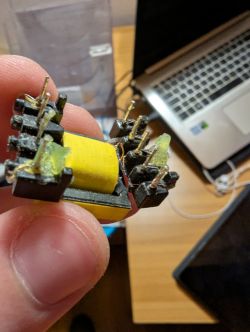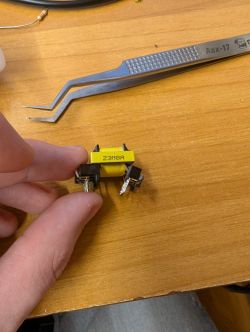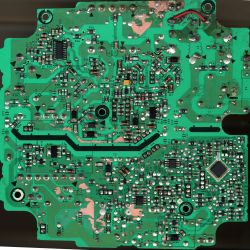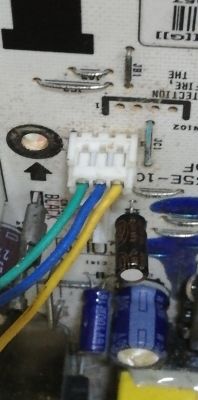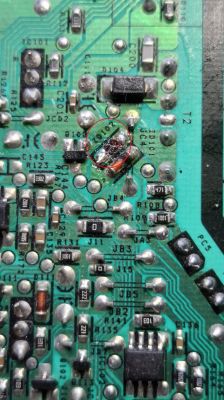FAQ
TL;DR: 80 % of C4/36-350 shutdowns are “caused by the MIP2M2 plus three 1 Ω resistors” [Elektroda, DRAZEK87, post #20760785] “Replace the chip and the charger works” [Elektroda, teskot, post #18916140]
Why it matters: Fixing this €200 charger often costs < €5 in parts.
Quick Facts
• Stand-by LED blinks every 2 s = no HV supply, check MIP2M2 chain [Elektroda, rsv6, post #17267845]
• Correct DC on C3 main cap: 320–330 VDC at 230 VAC input [Elektroda, DRAZEK87, post #20873167]
• L6599AD VCC must stay 12–16 V (14 V typical) or the main inverter latches off [STMicro, 2019].
• Optocoupler PC4 turns on only with battery inserted; LED side gets 4–6 mA from MCU pin 7 [Elektroda, florian_1034, post #21313155]
Why does the green LED flash every 2 seconds with no battery?
The flash means the standby SMPS around MIP2M2 lacks a stable 13 V output. Check the three series 1 Ω resistors (R24 / R30 / R33). If any are open, pin 4 (VCC) of MIP2M2 collapses and the LED blinks [Elektroda, PiterSen151, post #20873381]
Which parts fail most often in Hilti C4/36-350 chargers?
Forum repairs show 80 % of dead units need only the MIP2M2 IC plus the three 1 Ω resistors replaced; 60 % of those also need the L6599AD driver IC [Elektroda, DRAZEK87, post #20760785]
How do I test if my MIP2M2 is shorted?
With power off, measure resistance between pins 5 and 7. Anything below 300 kΩ (often tens of ohms) means the internal MOSFET is shorted and the IC is dead [Elektroda, DRAZEK87, post #20873559]
The charger clicks on for 5 s then stops—what now?
That pattern means the MCU sees no charge current. Common reasons:
- L6599AD not powered (PC4 path open).
- High-side MOSFETs Q3/Q4 shorted or open.
- Current-sense network (R31 + ZD16 + D9) faulty [Elektroda, teskot, post #18916140]
What voltage should be on C3 main capacitor?
At 230 VAC the rectifier, triac and EMC filter should leave 320–330 VDC on C3. If it pulses or stays < 200 V, check Q10 (BSS138N), Q7 (BC817DPN) and ZD1-ZD6 75 V TVS ladder that drive triac CR1 [Elektroda, DRAZEK87, post #20872003]
Can I replace optocoupler VO615A-9 with PC817?
Yes. Multiple users confirmed PC817 works for PC3 and PC5 positions without altering feedback accuracy [Elektroda, krakarak, post #20418803]
Edge-case: why does my LED smoke at power-up?
If LED100 sees > 12 V it overheats. This happens when PC5 fails—R111/R112 divider opens and C111 rises to 12–13 V instead of 8.4 V. Replace PC5 and rebuild the divider [Elektroda, vkudryakov, post #21551803]
How to quickly verify the HV stage before buying parts?
- Un-solder MIP2M2 and MOSFET keys.
- Apply mains; measure 320 V on C3.
- Confirm pin 5 pad shows 320 V and pin 4 pad ~0.5 V. If ok, HV section is healthy [Elektroda, DRAZEK87, post #20873167]
What is the small SMPS transformer marked Z3M8A?
It is the 13 V/8.4 V auxiliary flyback for logic power. No commercial replacement exists; salvage from donors or rewind (primary 2×110 T, secondary 2×12 T 0.3 mm, measured on intact unit) [Elektroda, manuelconso98, post #21528235]
My charger works only with nearly full batteries—why?
The MCU disables charge if cell voltage < 24 V and current feedback missing. Faulty shunt resistor R105 or op-amp LM358 (IC103) causes premature cutoff at low pack voltage [Elektroda, marchakoleg911, post #21480299]
Which MOSFET can replace the original 12NM50ND?
Any 500–600 V, ≥10 A, ≤0.4 Ω fast MOSFET in TO-220FP works. Tested: STF15N60K5 without insulating washer [Elektroda, piterkkpiotrk, post #20487944]
How do I reset latch-off after a fault?
Simply remove AC for 10 s. Both MIP2M2 and L6599AD use latched protections that clear only after VCC drops below 4 V [STMicro, 2019].
What’s the function of PTC1 beside Q4?
It is a 470 Ω PTC. When Q4 heat-sink exceeds ~125 °C its resistance rises, DIS pin sees > 1.8 V and L6599AD shuts down [Elektroda, DRAZEK87, post #20801282]
3-step quick fix for ‘dead-silent’ units
- Measure C3; if < 300 V replace triac CR1 or ZD1-ZD6 ladder.
- If 320 V present, check R24/R30/R33 for 1 Ω open.
- Still dead? Replace MIP2M2 and verify 13 V on pin 4.



